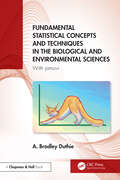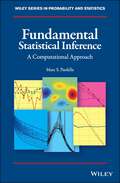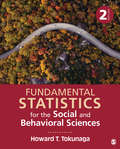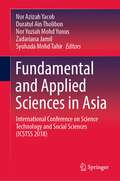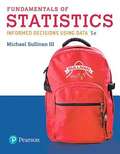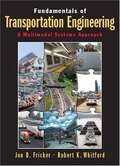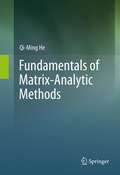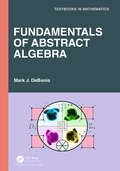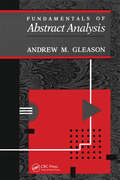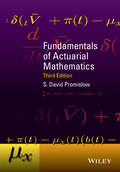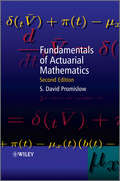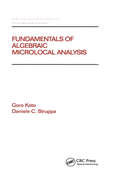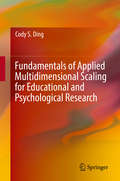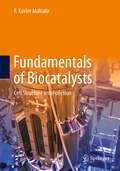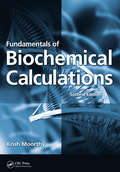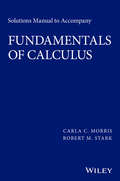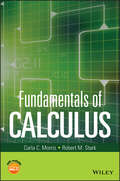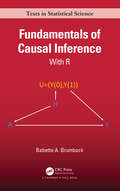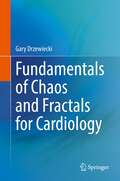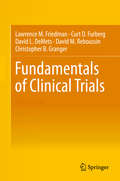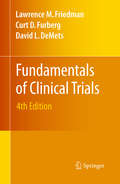- Table View
- List View
Fundamental Statistical Concepts and Techniques in the Biological and Environmental Sciences: With jamovi
by A. Bradley DuthieFundamental Statistical Concepts and Techniques in the Biological and Environmental Sciences: With jamovi is an introductory textbook for learning statistics. It starts with the very basics and prioritises helping the reader to develop a conceptual understanding of statistics, and apply the most fundamental statistical tools. New concepts are introduced with examples designed to be familiar to the reader, serving as a useful starting point for exploring more abstract concepts.Key Features: Designed to be accessible for students learning statistics in biological and environmental sciences. Utilizes the statistical software jamovi to explore new concepts. Prioritizes good statistical judgement over adherence to protocols. This book will be useful to students beginning their study of statistical concepts in biological and environmental sciences, whilst also acting as an insightful resource for teachers using jamovi in the classroom. Fundamental Statistical Concepts and Techniques in the Biological and Environmental Sciences: With jamovi is a valuable resource for anyone who wishes to understand and apply statistical techniques commonly used in the biological and environmental sciences.
Fundamental Statistical Inference: A Computational Approach (Wiley Series in Probability and Statistics)
by Marc S. PaolellaA hands-on approach to statistical inference that addresses the latest developments in this ever-growing field This clear and accessible book for beginning graduate students offers a practical and detailed approach to the field of statistical inference, providing complete derivations of results, discussions, and MATLAB programs for computation. It emphasizes details of the relevance of the material, intuition, and discussions with a view towards very modern statistical inference. In addition to classic subjects associated with mathematical statistics, topics include an intuitive presentation of the (single and double) bootstrap for confidence interval calculations, shrinkage estimation, tail (maximal moment) estimation, and a variety of methods of point estimation besides maximum likelihood, including use of characteristic functions, and indirect inference. Practical examples of all methods are given. Estimation issues associated with the discrete mixtures of normal distribution, and their solutions, are developed in detail. Much emphasis throughout is on non-Gaussian distributions, including details on working with the stable Paretian distribution and fast calculation of the noncentral Student's t. An entire chapter is dedicated to optimization, including development of Hessian-based methods, as well as heuristic/genetic algorithms that do not require continuity, with MATLAB codes provided. The book includes both theory and nontechnical discussions, along with a substantial reference to the literature, with an emphasis on alternative, more modern approaches. The recent literature on the misuse of hypothesis testing and p-values for model selection is discussed, and emphasis is given to alternative model selection methods, though hypothesis testing of distributional assumptions is covered in detail, notably for the normal distribution. Presented in three parts—Essential Concepts in Statistics; Further Fundamental Concepts in Statistics; and Additional Topics—Fundamental Statistical Inference: A Computational Approach offers comprehensive chapters on: Introducing Point and Interval Estimation; Goodness of Fit and Hypothesis Testing; Likelihood; Numerical Optimization; Methods of Point Estimation; Q-Q Plots and Distribution Testing; Unbiased Point Estimation and Bias Reduction; Analytic Interval Estimation; Inference in a Heavy-Tailed Context; The Method of Indirect Inference; and, as an appendix, A Review of Fundamental Concepts in Probability Theory, the latter to keep the book self-contained, and giving material on some advanced subjects such as saddlepoint approximations, expected shortfall in finance, calculation with the stable Paretian distribution, and convergence theorems and proofs.
Fundamental Statistics for the Behavioral Sciences 8th Edition
by David C. HowellFUNDAMENTAL STATISTICS FOR THE BEHAVIORAL SCIENCES focuses on providing the context of statistics in behavioral research, while emphasizing the importance of looking at data before jumping into a test. This practical approach provides readers with an understanding of the logic behind the statistics, so they understand why and how certain methods are used--rather than simply carry out techniques by rote. Readers move beyond number crunching to discover the meaning of statistical results and appreciate how the statistical test to be employed relates to the research questions posed by an experiment. An abundance of real data and research studies provide a real-life perspective and help you understand concepts as you learn about the analysis of data.
Fundamental Statistics for the Social and Behavioral Sciences
by Howard T. TokunagaFundamental Statistics for the Social and Behavioral Sciences, Second Edition places statistics within the research process, illustrating how they are used to answer questions and test ideas. Students learn not only how to calculate statistics, but also how to interpret and communicate the results of statistical analyses in light of a study’s research hypothesis. Featuring accessible writing and well-integrated research examples, the book gives students a greater understanding of how research studies are conceived, conducted, and communicated. New and Proven Features Updated data sets and research examples address real-world issues and topics across the social and behavioral sciences, illustrating the use of statistical procedures to test research questions and hypotheses. Significantly expanded discussion of linear and multiple regression and correlation now gives regression its own separate chapter. Thorough presentation of formulas, hand calculations, and the presentation of visual data enable mastery of key techniques and prove especially helpful in flipped or online classes. In-chapter learning checks and end-of-chapter exercises give students an opportunity to continually assess their understanding. Screenshots of statistical calculations using IBM® SPSS® Statistics at the end of chapters help students learn to use SPSS software and interpret output. Original SAGE videos for each chapter, featuring author Howard K. Tokunaga, bring concepts to life and appeal to diverse learners.
Fundamental Statistics for the Social and Behavioral Sciences
by Howard T. TokunagaFundamental Statistics for the Social and Behavioral Sciences, Second Edition places statistics within the research process, illustrating how they are used to answer questions and test ideas. Students learn not only how to calculate statistics, but also how to interpret and communicate the results of statistical analyses in light of a study’s research hypothesis. Featuring accessible writing and well-integrated research examples, the book gives students a greater understanding of how research studies are conceived, conducted, and communicated. New and Proven Features Updated data sets and research examples address real-world issues and topics across the social and behavioral sciences, illustrating the use of statistical procedures to test research questions and hypotheses. Significantly expanded discussion of linear and multiple regression and correlation now gives regression its own separate chapter. Thorough presentation of formulas, hand calculations, and the presentation of visual data enable mastery of key techniques and prove especially helpful in flipped or online classes. In-chapter learning checks and end-of-chapter exercises give students an opportunity to continually assess their understanding. Screenshots of statistical calculations using IBM® SPSS® Statistics at the end of chapters help students learn to use SPSS software and interpret output. Original SAGE videos for each chapter, featuring author Howard K. Tokunaga, bring concepts to life and appeal to diverse learners.
Fundamental and Applied Sciences in Asia: International Conference on Science Technology and Social Sciences (ICSTSS 2018)
by Nor Azizah Yacob Nor Yuziah Mohd Yunus Duratul Ain Tholibon Zadariana Jamil Syuhada Mohd TahirThis book gathers selected science and technology papers presented at the 2018 International Conference on Science Technology and Social Sciences (ICSTSS 2018), organised bi-annually by Universiti Teknologi MARA Pahang, Malaysia. Based on the theme “Redesigning Education for Industrial Revolution”, the papers in this book address a broad range of topics in the fundamental and applied sciences, including computer science, engineering, environmental and management, furniture, forestry, health and medicine, material science, mathematics, plantation and agrotechnology, sport science and statistics, covering theoretical, numerical and experimental studies. The book serves as a platform for disseminating research findings by academicians of local, regional and global prominence, as a catalyst to inspire positive innovations in the development of the region. It provides a significant point of reference for academicians and students: for academicians, it is a good source of information to conduct further research; for students, it is the latest point of reference on research conducted in their fields of study. The carefully reviewed papers intend to facilitate the creation of new knowledge through the exchange of ideas, strategies and innovations in various science and technology disciplines, and to contribute towards enhancing the learning environment.
Fundamentals Of Statistics: Informed Decisions Using Data
by Michael SullivanFundamentals of Statistics is the brief version of Statistics: Informed Decisions Using Data. <p><p> With Fundamentals of Statistics, author and instructor Mike Sullivan III draws on his passion for statistics and teaching to provide the tools needed to see that statistics is connected, not only within individual concepts, but also in the world at large. As a current introductory statistics instructor, Mike Sullivan pulls ideas and strategies used in his classroom into more than 350 new and updated exercises, over 100 new and updated examples, new Retain Your Knowledge problems, and Big Data problems. This practical text takes advantage of the latest statistical software, enabling you to focus on building conceptual understanding rather than memorizing formulas. All resources, including the Student Activity Workbook and Author in the Classroom videos were created for Mike’s classroom to help you succeed and stay engaged.
Fundamentals Of Transportation Engineering: A Multimodal Systems Approach
by Jon D. Fricker Robert K. WhitfordCombining topics that are essential in an introductory course with information that is of interest to those who want to know why certain things in transportation are the way they are, the book provides a strong emphasis of the relationship between the phases of a transportation project. The volume familiarizes readers with the standard terminology and resources involved in transportation engineering, provides realistic scenarios for readers to analyze and offers numerous examples designed to develop problem solving skills. The volume examines transportation basics, traffic flow theory and analysis, highway design for performance, modeling transportation demand and supply, planning and evaluation for decision-making, design of highway for safety, design of intersections for safety and efficiency, pavement design, public mass transportation, air transportation and airports and environmental issues/emerging technologies. For those interested in transportation engineering.
Fundamentals of Matrix-Analytic Methods
by Qi-Ming HeFundamentals of Matrix-Analytic Methods targets advanced-level students in mathematics, engineering and computer science. It focuses on the fundamental parts of Matrix-Analytic Methods, Phase-Type Distributions, Markovian arrival processes and Structured Markov chains and matrix geometric solutions. New materials and techniques are presented for the first time in research and engineering design. This book emphasizes stochastic modeling by offering probabilistic interpretation and constructive proofs for Matrix-Analytic Methods. Such an approach is especially useful for engineering analysis and design. Exercises and examples are provided throughout the book.
Fundamentals of Abstract Algebra (Textbooks in Mathematics)
by Mark J. DeBonisFundamentals of Abstract Algebra is a primary textbook for a one year first course in Abstract Algebra, but it has much more to offer besides this. The book is full of opportunities for further, deeper reading, including explorations of interesting applications and more advanced topics, such as Galois theory. Replete with exercises and examples, the book is geared towards careful pedagogy and accessibility, and requires only minimal prerequisites. The book includes a primer on some basic mathematical concepts that will be useful for readers to understand, and in this sense the book is self-contained.Features Self-contained treatments of all topics Everything required for a one-year first course in Abstract Algebra, and could also be used as supplementary reading for a second course Copious exercises and examples Mark DeBonis received his PhD in Mathematics from the University of California, Irvine, USA. He began his career as a theoretical mathematician in the field of group theory and model theory, but in later years switched to applied mathematics, in particular to machine learning. He spent some time working for the US Department of Energy at Los Alamos National Lab as well as the US Department of Defense at the Defense Intelligence Agency, both as an applied mathematician of machine learning. He held a position as Associate Professor of Mathematics at Manhattan College in New York City, but later left to pursue research working for the US Department of Energy at Sandia National Laboratory as a Principal Data Analyst. His research interests include machine learning, statistics and computational algebra.
Fundamentals of Abstract Analysis
by Andrew GleasonThis classic is an ideal introduction for students into the methodology and thinking of higher mathematics. It covers material not usually taught in the more technically-oriented introductory classes and will give students a well-rounded foundation for future studies.
Fundamentals of Actuarial Mathematics
by S. David PromislowThis book provides a comprehensive introduction to actuarial mathematics, covering both deterministic and stochastic models of life contingencies, as well as more advanced topics such as risk theory, credibility theory and multi-state models.This new edition includes additional material on credibility theory, continuous time multi-state models, more complex types of contingent insurances, flexible contracts such as universal life, the risk measures VaR and TVaR.Key Features:Covers much of the syllabus material on the modeling examinations of the Society of Actuaries, Canadian Institute of Actuaries and the Casualty Actuarial Society. (SOA-CIA exams MLC and C, CSA exams 3L and 4.)Extensively revised and updated with new material.Orders the topics specifically to facilitate learning.Provides a streamlined approach to actuarial notation.Employs modern computational methods.Contains a variety of exercises, both computational and theoretical, together with answers, enabling use for self-study.An ideal text for students planning for a professional career as actuaries, providing a solid preparation for the modeling examinations of the major North American actuarial associations. Furthermore, this book is highly suitable reference for those wanting a sound introduction to the subject, and for those working in insurance, annuities and pensions.
Fundamentals of Actuarial Mathematics
by S. David PromislowThis book provides a comprehensive introduction to actuarial mathematics, covering both deterministic and stochastic models of life contingencies, as well as more advanced topics such as risk theory, credibility theory and multi-state models. This new edition includes additional material on credibility theory, continuous time multi-state models, more complex types of contingent insurances, flexible contracts such as universal life, the risk measures VaR and TVaR. Key Features: Covers much of the syllabus material on the modeling examinations of the Society of Actuaries, Canadian Institute of Actuaries and the Casualty Actuarial Society. (SOA-CIA exams MLC and C, CSA exams 3L and 4.) Extensively revised and updated with new material. Orders the topics specifically to facilitate learning. Provides a streamlined approach to actuarial notation. Employs modern computational methods. Contains a variety of exercises, both computational and theoretical, together with answers, enabling use for self-study. An ideal text for students planning for a professional career as actuaries, providing a solid preparation for the modeling examinations of the major North American actuarial associations. Furthermore, this book is highly suitable reference for those wanting a sound introduction to the subject, and for those working in insurance, annuities and pensions.
Fundamentals of Algebra Practice Book (Progress in Mathematics)
by Catherine D. Le Tourneau Alfred S. Posamentier Edward Wiliam Quinn*This textbook has been transcribed in UEB, formatted according to Braille textbook formats, proofread and corrected. <P><P> Progress in Mathematics 2009 Student Edition Practice Book Grade 7 In alignment with the Common Core State Standards, the scope and sequence of Fundamentals of Algebra is organized into bite-sized, manageable lessons allowing for deeper understanding of skills and concepts so students get the necessary skills for Algebra and beyond. Fundamentals of Algebra: • Focuses on conceptual development for all learners. • Builds knowledge lesson by lesson and across grade levels with coherent lessons. • Develops fluency and conceptual understanding in a multitude of ways. • Deepens understanding with vocabulary, cognitive rigor, and higher-level thinking skills. The Sourcebook allows students to focus on learning skills and concepts before moving onto independent practice in the Practice Book.
Fundamentals of Algebraic Microlocal Analysis (Chapman And Hall/crc Pure And Applied Mathematics Ser. #217)
by Goro Kato Daniele C Struppa"Provides a thorough introduction to the algebraic theory of systems of differential equations, as developed by the Japanese school of M. Sato and his colleagues. Features a complete review of hyperfunction-microfunction theory and the theory of D-modules. Strikes the perfect balance between analytic and algebraic aspects."
Fundamentals of Applied Multidimensional Scaling for Educational and Psychological Research
by Cody S. DingThis book explores the fundamentals of multidimensional scaling (MDS) and how this analytic method can be used in applied setting for educational and psychological research. The book tries to make MDS more accessible to a wider audience in terms of the language and examples that are more relevant to educational and psychological research and less technical so that the readers are not overwhelmed by equations. The goal is for readers to learn the methods described in this book and immediately start using MDS via available software programs. The book also examines new applications that have previously not been discussed in MDS literature. It should be an ideal book for graduate students and researchers to better understand MDS. Fundamentals of Applied Multidimensional Scaling for Educational and Psychological Research is divided into three parts. Part I covers the basic and fundamental features of MDS models pertaining to applied research applications. Chapters in this section cover the essential features of data that are typically associated with MDS analysis such as preference ration or binary choice data, and also looking at metric and non-metric MDS models to build a foundation for later discussion and applications in later chapters. Part II examines specific MDS models and its applications for education and psychology. This includes spatial analysis methods that can be used in MDS to test clustering effect of items and individual differences MDS model (INDSCAL). Finally, Part III focuses on new applications of MDS analysis in these research fields. These new applications consist of profile analysis, longitudinal analysis, mean-level change, and pattern change. The book concludes with a historical review of MDS development as an analytical method and a look to future directions.
Fundamentals of Biocatalysts: Cell Structure and Function
by F. Xavier MalcataThis textbook covers the essentials of cells as biocatalysts, including cell morphology, cell genetics, cell metabolism, cell operation, cell stoichiometry, cell engineering, and cell interaction. A pragmatic and systematic approach is provided to all such topics, from the point of view of a biological engineer – illustrated by criteriously selected and carefully solved problems, proposed at the end of each section. In the first part of this textbook, readers will find a brief historical review of biotechnology; and in the second part, the author explores the performance of biocatalysts, in terms of native features and upon rational manipulation thereof. Whenever appropriate, mathematical derivations are put forward that are easy to follow step-by-step – even by students holding only elementary mathematical and biochemical backgrounds; and are developed at a pace suitable for self-learning. Furthermore, the functional forms and meanings of the expressionsproduced are explored, and the final germane formulae are duly highlighted and graphically interpreted in dimensionless form – to facilitate the perception of major trends and asymptotic patterns. Therefore, this book offers a valuable resource for both instructors and undergraduate/graduate students – as an aid to grasp and relate basic concepts dealing with living cells as catalysts designed for bioreactors, rather than engaging in cumbersome descriptions of their physiological behaviour.This textbook, together with the companion volumes Operation Fundamentals in Bioreactor Engineering and Modelling Fundamentals in Bioreactor Engineering, fill the gap between qualitative approaches, focused on biochemistry; and technological approaches, which often resort to empirical correlations – unlikely to support a fundamental understanding of the essential concepts.
Fundamentals of Biochemical Calculations
by Krish MoorthyFundamentals of Biochemical Calculations, Second Edition demystifies the fundamental calculations used in modern biochemistry, cell biology, and allied biomedical sciences. The book encouragesbothundergraduates and scientists to develop an understanding of the processes involved in performing biochemical calculations, rather than rely on mem
Fundamentals of Calculus
by Robert M. Stark Carla C. MorrisFeatures the techniques, methods, and applications of calculus using real-world examples from business and economics as well as the life and social sciences An introduction to differential and integral calculus, Fundamentals of Calculus presents key topics suited for a variety of readers in fields ranging from entrepreneurship and economics to environmental and social sciences. Practical examples from a variety of subject areas are featured throughout each chapter and step-by-step explanations for the solutions are presented. Specific techniques are also applied to highlight important information in each section, including symbols interspersed throughout to further reader comprehension. In addition, the book illustrates the elements of finite calculus with the varied formulas for power, quotient, and product rules that correlate markedly with traditional calculus. Featuring calculus as the "mathematics of change," each chapter concludes with a historical notes section. Fundamentals of Calculus chapter coverage includes: Linear Equations and Functions The Derivative Using the Derivative Exponents and Logarithms Differentiation Techniques Integral Calculus Integrations Techniques Functions of Several Variables Series and Summations Applications to Probability Supplemented with online instructional support materials, Fundamentals of Calculus is an ideal textbook for undergraduate students majoring in business, economics, biology, chemistry, and environmental science.
Fundamentals of Calculus
by Robert M. Stark Carla C. MorrisFeatures the techniques, methods, and applications of calculus using real-world examples from business and economics as well as the life and social sciences An introduction to differential and integral calculus, Fundamentals of Calculus presents key topics suited for a variety of readers in fields ranging from entrepreneurship and economics to environmental and social sciences. Practical examples from a variety of subject areas are featured throughout each chapter and step-by-step explanations for the solutions are presented. Specific techniques are also applied to highlight important information in each section, including symbols interspersed throughout to further reader comprehension. In addition, the book illustrates the elements of finite calculus with the varied formulas for power, quotient, and product rules that correlate markedly with traditional calculus. Featuring calculus as the “mathematics of change,” each chapter concludes with a historical notes section. Fundamentals of Calculus chapter coverage includes: Linear Equations and Functions The Derivative Using the Derivative Exponents and Logarithms Differentiation Techniques Integral Calculus Integrations Techniques Functions of Several Variables Series and Summations Applications to Probability Supplemented with online instructional support materials, Fundamentals of Calculus is an ideal textbook for undergraduate students majoring in business, economics, biology, chemistry, and environmental science.
Fundamentals of Causal Inference: With R (Chapman & Hall/CRC Texts in Statistical Science)
by Babette A. BrumbackOne of the primary motivations for clinical trials and observational studies of humans is to infer cause and effect. Disentangling causation from confounding is of utmost importance. Fundamentals of Causal Inference explains and relates different methods of confounding adjustment in terms of potential outcomes and graphical models, including standardization, difference-in-differences estimation, the front-door method, instrumental variables estimation, and propensity score methods. It also covers effect-measure modification, precision variables, mediation analyses, and time-dependent confounding. Several real data examples, simulation studies, and analyses using R motivate the methods throughout. The book assumes familiarity with basic statistics and probability, regression, and R and is suitable for seniors or graduate students in statistics, biostatistics, and data science as well as PhD students in a wide variety of other disciplines, including epidemiology, pharmacy, the health sciences, education, and the social, economic, and behavioral sciences. Beginning with a brief history and a review of essential elements of probability and statistics, a unique feature of the book is its focus on real and simulated datasets with all binary variables to reduce complex methods down to their fundamentals. Calculus is not required, but a willingness to tackle mathematical notation, difficult concepts, and intricate logical arguments is essential. While many real data examples are included, the book also features the Double What-If Study, based on simulated data with known causal mechanisms, in the belief that the methods are best understood in circumstances where they are known to either succeed or fail. Datasets, R code, and solutions to odd-numbered exercises are available at www.routledge.com.
Fundamentals of Chaos and Fractals for Cardiology
by Gary DrzewieckiThis textbook serves as an introduction to nonlinear dynamics and fractals for physiological modeling. Examples and demonstrations from current research in cardiopulmonary engineering and neuro-systems engineering are provided, as well as lab and computer exercises that encourage readers to apply the course material. This is an ideal textbook for graduate students in biomedical engineering departments, researchers who analyze physiological data, and researchers interested in physiological modeling.
Fundamentals of Clinical Trials
by Lawrence M. Friedman Curt D. Furberg David M. Reboussin Christopher B. Granger David L. DeMetsThis is the fifth edition of a very successful textbook on clinical trials methodology, written by recognized leaders who have long and extensive experience in all areas of clinical trials. The three authors of the first four editions have been joined by two others who add great expertise. A chapter on regulatory issues has been included and the chapter on data monitoring has been split into two and expanded. Many contemporary clinical trial examples have been added. There is much new material on adverse events, adherence, issues in analysis, electronic data, data sharing and international trials.This book is intended for the clinical researcher who is interested in designing a clinical trial and developing a protocol. It is also of value to researchers and practitioners who must critically evaluate the literature of published clinical trials and assess the merits of each trial and the implications for the care and treatment of patients. The authors use numerous examples of published clinical trials to illustrate the fundamentals.The text is organized sequentially from defining the question to trial closeout. One chapter is devoted to each of the critical areas to aid the clinical trial researcher. These areas include pre-specifying the scientific questions to be tested and appropriate outcome measures, determining the organizational structure, estimating an adequate sample size, specifying the randomization procedure, implementing the intervention and visit schedules for participant evaluation, establishing an interim data and safety monitoring plan, detailing the final analysis plan and reporting the trial results according to the pre-specified objectives.Although a basic introductory statistics course is helpful in maximizing the benefit of this book, a researcher or practitioner with limited statistical background would still find most if not all the chapters understandable and helpful. While the technical material has been kept to a minimum, the statistician may still find the principles and fundamentals presented in this text useful.
Fundamentals of Clinical Trials
by Lawrence M. Friedman Curt D. Furberg David L. DemetsThis is the fourth edition of a very successful textbook on clinical trials methodology, written by three recognized experts who have long and extensive experience in all areas of clinical trials. Most chapters have been revised considerably from the third edition. A chapter on ethics has been added and topics such as noninferiority and adaptive designs now receive considerable discussion. There is much new material on adverse events, adherence, data monitoring, and issues in analysis. This book is intended for the clinical researcher who is interested in designing a clinical trial and developing a protocol. It is also of value to researchers and practitioners who must critically evaluate the literature of published clinical trials and assess the merits of each trial and the implications for the care and treatment of patients. The authors use numerous examples of published clinical trials from a variety of medical disciplines to illustrate the fundamentals. The text is organized sequentially from defining the question to trial closeout. One chapter is devoted to each of the critical areas to aid the clinical trial researcher. These areas include pre-specifying the scientific questions to be tested and appropriate outcome measures, determining the organizational structure, estimating an adequate sample size, specifying the randomization procedure, implementing the intervention and visit schedules for participant evaluation, establishing an interim data and safety monitoring plan, detailing the final analysis plan, and reporting the trial results according to the pre-specified objectives. Although a basic introductory statistics course is helpful in maximizing the benefit of this book, a researcher or practitioner with limited statistical background would still find most if not all the chapters understandable and helpful. While the technical material has been kept to a minimum, the statistician may still find the principles and fundamentals presented in this text useful. This book has been successfully used for teaching courses in clinical trial methodology.
Fundamentals of College Algebra (10th Edition)
by Earl William Swokowski Jeffrey A. ColeThis textbook introduces two-dimensional graphs, polynomial, inverse, exponential, and logarithmic functions, and methods for solving systems of inequalities and plane geometry. Keystroke instructions for the TI-83 Plus and TI-86 calculators are provided throughout. The eleventh edition features 100 new examples and exercises. Annotation ©2004 Book News, Inc., Portland, OR (booknews.com)
